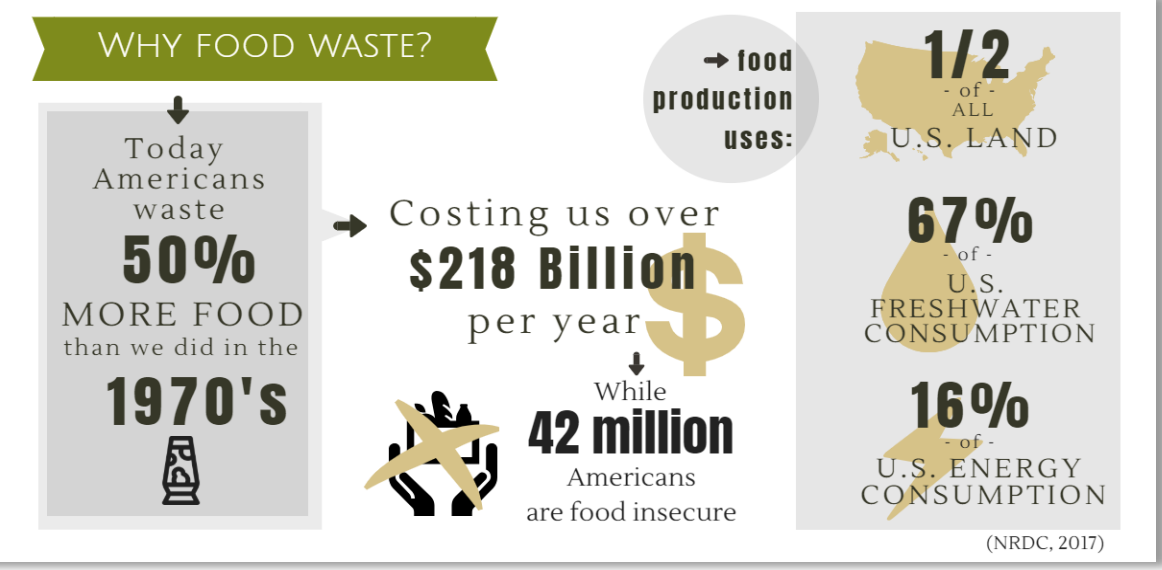Organic waste, which includes food scraps, yard trimmings, and other biodegradable materials, contributes to 30% of United States (US) municipal solid waste and 14% of US methane emissions (EPA, 2021; Gunders, 2017). Food waste alone amounts to 22% of the entire municipal solid waste stream, with 40% of the US food supply uneaten (EPA, 2021; Sandson et al, 2019). Together, food waste and yard trimmings account for 11% of all landfill-generated methane and 8% of the world’s greenhouse gasses – the equivalent of emissions from 3.7 million vehicles each year (Sanderson et al, 2019; Gunders, 2017; Frischmann, 2021). Wasted organic materials drain other resources, as well. Despite allocating 20% of its land and freshwater to food crop growth, the United States wastes 133 billion pounds of food every year. This results in a current conservative estimate of $161 billion retail and consumer loss (USFDA, 2021).

In response to this crisis, the USDA and EPA publicized the nation’s first-ever national food waste goal to reduce waste by 50% by 2030 (USDA, 2015). In October 2020, the New Jersey Department of Environmental Protection released its Global Warming Response Act 80 x 50 Report, which identifies pathways to reduce state greenhouse gas emissions to 80% of 2006 levels by 2050 (NJDEP, 2020).

Several existing in-state networks offer opportunities to improve organics management practices. AgChoice composting facility in Newton, NJ introduced an in-state composting service for those who prefer to remove compost from their properties. Sustainable New Jersey, REPLENISH food distribution agency, and Feeding New Brunswick network provide tools, training, and financial incentives to support community efforts to reduce waste, minimize greenhouse gas emissions, promote sustainable education, and eradicate hunger. Across the state, strategically located farmers markets, buy local campaigns, and food pantries increase the accessibility and awareness of nutritious food in food insecure communities. On a more individual level, phone applications like 412 Food Rescue, Food Rescue US, and Too Good to Go connect food surplus from cafeteria and restaurant kitchens to food pantries and social service agencies. This non-exhaustive list of examples demonstrates the scope of organic waste reduction efforts in New Jersey, the potential to centralize resources across the state, and the opportunities to mobilize community action.
Even with this established in-state infrastructure for climate equity, a preliminary review of the literature identifies opportunities for New Jersey state policy leadership in effective organic waste management. In many respects, New Jersey climate policy lags behind that of leaders nearby in New England. Other states offer effective models of in-school food sharing tables, food rescue financing and coordination, stakeholder engagement, food waste co-digestion, composting requirements, and economies for sustainable practices.
In pursuit of USDA, EPA, and NJDEP organic waste objectives, the work we are doing funded by the NJ Policy Lab investigates how other leading states’ organic waste policies approach food waste and compiles findings on economic impacts, stakeholder engagement strategies, and effective regulatory reforms. With input from the Organics Workgroup of the NJ Climate Change Alliance, project members will draft a report to augment the opportunities for action in sustainable organics material management identified by the stakeholder-informed NJ Organic Material Management Plan. The report will inform the development of statewide public policy aimed at reducing food waste, contributing to food security, and driving waste from landfills. This work is sponsored by the New Jersey Policy Lab and supported by the New Jersey Climate Change Alliance, an initiative facilitated by Rutgers University.
Anna Heckler is a Master of Public Policy Student at the Rutgers University Bloustein School. She is a member of the New Jersey Climate Change Resource Center Climate Corps and, with support from the State Policy Lab, is engaged in a project on the topic of organic waste management to support efforts of the New Jersey Climate Change Alliance.
References:
Bayshore Recycling. August 2021. “The New Jersey Climate Change Alliance Organics Workgroup: Sustainable Organic Material Management Plan.” https://www.bayshorerecycling.com/wp-content/uploads/2021/09/Organics-Workgroup-SOMMP-Final-Sept-2021.pdf (accessed September 29, 2021).
US Environmental Protection Agency. July 2021. “National Overview: Facts and Figures on Materials, Wastes and Recycling.” https://www.epa.gov/facts-and-figures-about-materials-waste-and-recycling/national-overview-facts-and-figures-materials (accessed October 2, 2021).
FAO. 2011. Global food losses and food waste – Extent, causes and prevention. Rome.
Frischmann, Chad and Mehra, Mamta. 2021. “Massively Reducing Food Waste Could Feed the World.” https://www.scientificamerican.com/article/massively-reducing-food-waste-could-feed-the-world/ (accessed September 30, 2021).
Gunders, D. (2017). Wasted: How America is losing up to 40 percent of its food from farm to fork to landfill. Natural Resources Defense Council, 26, 1-26.
New Jersey Department of Environmental Protection. 2020. “NJDEP Global Warming Response Act 80 x 50 Report.” https://www.state.nj.us/dep/climatechange/mitigation.html (accessed September 29, 2021).
New Jersey Department of Environmental Protection: SEEDS. November 2019. “The State of New Jersey School Food Waste Guidelines.” https://www.nj.gov/dep/seeds/sfwg/docs/HighEd.pdf (accessed September 29, 2021).
Sandson, K., Broad Leib, E., Macaluso, L., & Mansell, C. (2019). Bans And Beyond: Designing and Implementing Organic Waste Bans and Mandatory Organics Recycling Laws. The Harvard Law School Food Law and Policy Clinic: Cambridge, MA, USA.
US Food and Drug Administration. April 2021. “Food Loss and Waste.” https://www.fda.gov/food/consumers/food-loss-and-waste (accessed October 2, 2021).
United States Department of Agriculture (USDA), Economic Research Service, Economic Bulletin No. (EIB-16), “Agricultural Resources and Environmental Indicators,” Chapter 2.1, July 2006, https://people.duke.edu/~rcd2/Dissertation/References/Data%20Specific/eib16.pdf
US Department of Agriculture. 2015. “United States 2030 Food Loss and Waste Reduction Goal” https://www.epa.gov/sustainable-management-food/united-states-2030-food-loss-and-waste-reduction-goal#goal (accessed September 29, 2021).
